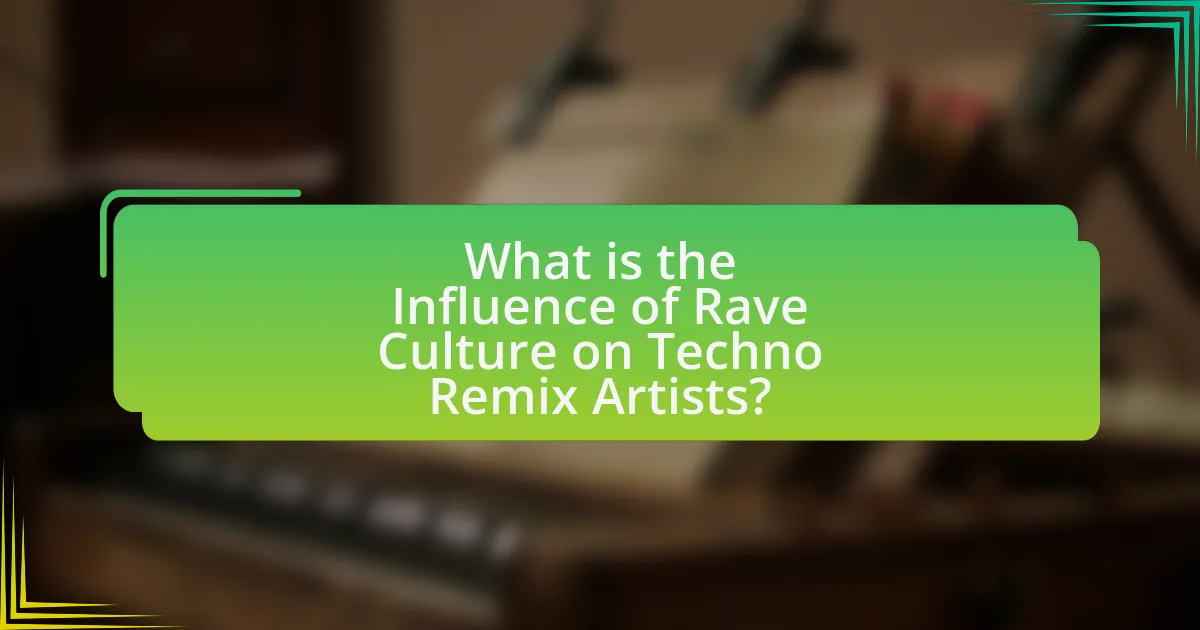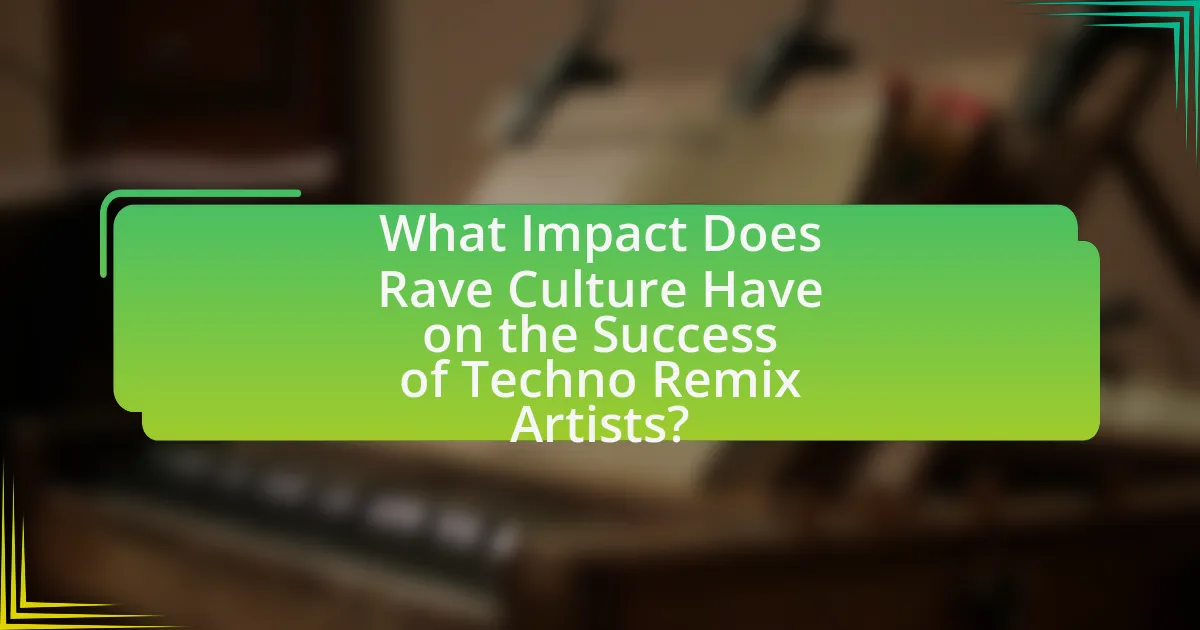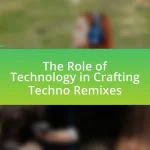The article examines the significant influence of rave culture on techno remix artists, highlighting how this cultural movement shapes their musical styles, performance aesthetics, and community engagement. It traces the origins and evolution of rave culture, detailing key events and music styles that have defined the scene since the late 1980s. The article also explores the defining characteristics of rave culture, the role of community, and how remix artists interpret and reflect these values in their work. Additionally, it addresses the challenges faced by artists within this context and offers strategies for maintaining relevance in the ever-evolving rave landscape.

What is the Influence of Rave Culture on Techno Remix Artists?
Rave culture significantly influences techno remix artists by shaping their musical styles, performance aesthetics, and community engagement. The immersive experiences and communal atmosphere of raves encourage artists to experiment with sound and create tracks that resonate with the euphoric and energetic vibes of these events. For instance, the incorporation of repetitive beats and synthesized sounds in techno music mirrors the auditory experiences found in rave settings, which aim to induce trance-like states among participants. Additionally, the visual elements of rave culture, such as light shows and vibrant visuals, inspire remix artists to enhance their performances, making them more engaging and memorable. This connection is evident in the rise of artists who blend traditional techno elements with influences from rave culture, resulting in innovative remixes that cater to the evolving tastes of the audience.
How did rave culture originate and evolve?
Rave culture originated in the late 1980s in the United Kingdom, emerging from the acid house movement and the underground dance music scene. This cultural phenomenon evolved through the integration of electronic music genres, such as techno, house, and trance, which were characterized by repetitive beats and synthesized sounds. The first large-scale raves took place in warehouses and outdoor locations, often organized clandestinely, reflecting a countercultural ethos.
As the 1990s progressed, rave culture expanded globally, influenced by the rise of the internet and the accessibility of DJ equipment, leading to the establishment of festivals and legal events. The culture also became associated with specific fashion styles, visual art, and a sense of community among participants. By the early 2000s, rave culture had diversified, incorporating various subgenres and styles, while also facing challenges such as legal crackdowns and concerns over drug use.
The evolution of rave culture has significantly impacted techno remix artists, who draw inspiration from its vibrant energy and innovative soundscapes, contributing to the ongoing development of electronic music.
What key events shaped the early rave scene?
The early rave scene was significantly shaped by the Acid House movement in the late 1980s, particularly marked by the 1988 Second Summer of Love in the UK, which saw mass gatherings and illegal raves. This movement was characterized by the use of ecstasy, a drug that enhanced the experience of electronic music, and the emergence of warehouse parties that attracted thousands of attendees. Additionally, the 1990 Criminal Justice Act in the UK, which aimed to curb unlicensed raves, inadvertently fueled the underground scene, leading to a greater sense of community and resistance among ravers. These events collectively established the cultural and social framework that defined early rave culture, influencing subsequent techno remix artists who drew inspiration from the vibrant, rebellious spirit of the scene.
How did the music styles within rave culture develop?
The music styles within rave culture developed through the fusion of various electronic genres, including house, techno, and acid house, which emerged in the late 1980s and early 1990s. This evolution was driven by the underground club scene and the desire for new, innovative sounds that could energize large gatherings. The incorporation of synthesizers, drum machines, and sampling techniques allowed artists to experiment and create distinct subgenres, such as trance and jungle, which further diversified the rave music landscape. The rise of raves as social events also influenced the music, as DJs began to mix tracks live, creating a continuous flow that enhanced the communal experience.
What are the defining characteristics of rave culture?
Rave culture is characterized by its emphasis on electronic dance music, vibrant visual aesthetics, and a sense of community among participants. The music, primarily electronic genres like techno, house, and trance, serves as the backbone of raves, often featuring high-energy beats and repetitive rhythms that encourage dancing. Visual elements include elaborate light shows, neon colors, and psychedelic art, which enhance the immersive experience. Additionally, rave culture promotes ideals of peace, love, unity, and respect, often encapsulated in the acronym PLUR. This culture emerged in the late 1980s and early 1990s, particularly in the UK and the US, as a response to the underground music scene, fostering a unique social environment that celebrates freedom of expression and inclusivity.
How does the aesthetic of rave culture influence music production?
The aesthetic of rave culture significantly influences music production by prioritizing high-energy beats, immersive soundscapes, and a sense of community. This aesthetic encourages producers to create tracks that are designed for collective experiences, often featuring repetitive rhythms and synthesized sounds that evoke euphoria and transcendence. For instance, the use of 4/4 kick drums and build-ups in techno tracks is a direct reflection of the rave environment, where the goal is to keep the audience engaged and dancing for extended periods. Additionally, visual elements such as neon colors and psychedelic imagery associated with rave culture inspire producers to incorporate similar themes into their music, enhancing the overall sensory experience. This connection between aesthetic and production techniques is evident in the works of artists like Derrick May and Jeff Mills, who have shaped the techno genre by embodying the rave ethos in their music.
What role does community play in the rave experience?
Community plays a crucial role in the rave experience by fostering a sense of belonging and shared identity among participants. This collective atmosphere enhances emotional connections, allowing individuals to feel part of a larger movement that values freedom, expression, and inclusivity. Research indicates that social interactions within rave settings contribute to heightened feelings of euphoria and unity, as evidenced by studies showing that communal experiences can amplify positive emotional states. Furthermore, the presence of a supportive community encourages creativity and collaboration, which are essential elements in the evolution of techno music and its remix culture.
Why is techno music significant within rave culture?
Techno music is significant within rave culture because it serves as the foundational genre that defines the sonic landscape of raves. Originating in the 1980s in Detroit, techno’s repetitive beats and synthesized sounds create an immersive experience that encourages collective dancing and a sense of community among participants. The genre’s emphasis on rhythm and tempo aligns perfectly with the high-energy atmosphere of raves, facilitating prolonged dance sessions that are central to the culture. Additionally, techno’s evolution has been closely tied to the underground rave scene, where it has fostered a spirit of experimentation and innovation, making it a driving force in shaping the identity and ethos of rave culture.
What elements of techno music resonate with rave audiences?
The elements of techno music that resonate with rave audiences include repetitive beats, synthesized sounds, and a driving bassline. These characteristics create an immersive experience that encourages dancing and a sense of unity among participants. The repetitive nature of the beats, often around 120-150 BPM, allows for a trance-like state, which is essential in rave culture. Additionally, the use of synthesized sounds and effects contributes to the futuristic and experimental vibe that attracts rave attendees. This combination fosters an environment where individuals can lose themselves in the music, enhancing the overall experience of the rave.
How has techno music adapted over the years in response to rave culture?
Techno music has evolved significantly over the years in response to rave culture by incorporating diverse subgenres, enhancing production techniques, and embracing a more immersive experience. Initially rooted in the underground scenes of Detroit and Chicago, techno began to integrate elements from house, trance, and ambient music as rave culture gained popularity in the 1990s. This fusion led to the emergence of styles like hard techno and minimal techno, which catered to the energetic and euphoric atmosphere of raves.
Moreover, advancements in technology, such as digital audio workstations and synthesizers, allowed artists to experiment with sound design, resulting in richer textures and complex rhythms that resonate with the rave experience. The rise of large-scale festivals and events further influenced techno artists to create longer, more dynamic sets that maintain audience engagement over extended periods.
The adaptability of techno music is evidenced by its global reach, with regional scenes in Europe, Asia, and South America developing unique interpretations that reflect local rave cultures. This ongoing evolution demonstrates how techno music continuously responds to the changing dynamics of rave culture, ensuring its relevance and vitality in the electronic music landscape.

How do Techno Remix Artists Interpret Rave Culture?
Techno remix artists interpret rave culture by infusing their music with the energetic and communal spirit characteristic of raves. This interpretation manifests through the use of repetitive beats, synthesized sounds, and immersive soundscapes that aim to create an ecstatic experience for listeners, mirroring the euphoric atmosphere of live rave events. For instance, artists often sample iconic rave tracks and incorporate elements like build-ups and drops to evoke the same emotional highs experienced on the dance floor. Additionally, the visual aesthetics of rave culture, such as neon colors and psychedelic imagery, influence the branding and presentation of techno remixes, further connecting the music to the broader cultural movement.
What techniques do remix artists use to capture the essence of rave culture?
Remix artists capture the essence of rave culture through techniques such as sampling, tempo manipulation, and the incorporation of ambient soundscapes. Sampling allows artists to integrate iconic rave tracks and vocal snippets, creating a nostalgic connection to the genre’s roots. Tempo manipulation, often increasing the beats per minute, energizes the music, aligning it with the high-energy atmosphere of raves. Additionally, the use of ambient soundscapes, including crowd noises and synthesized effects, immerses listeners in the rave experience, reflecting the communal and euphoric nature of these events. These techniques collectively reinforce the cultural significance of rave music within the techno genre.
How do sampling and layering contribute to the rave sound?
Sampling and layering are essential techniques that significantly shape the rave sound by creating rich, textured audio experiences. Sampling allows artists to incorporate diverse sounds, including snippets from other tracks, vocal phrases, or environmental noises, which adds depth and variety to the music. Layering involves stacking multiple sound elements, such as beats, synths, and effects, to build a fuller, more immersive soundscape that enhances the energetic atmosphere typical of rave events. This combination of sampling and layering not only fosters creativity but also reflects the eclectic nature of rave culture, where influences from various genres and styles converge to produce unique auditory experiences.
What role does live performance play in the interpretation of rave culture?
Live performance is central to the interpretation of rave culture as it embodies the communal experience and energy exchange that define the movement. Rave culture emphasizes collective participation, where live performances by DJs and artists create an immersive environment that fosters connection among attendees. This is evidenced by the historical significance of events like the Love Parade in Berlin, which attracted over 1.5 million participants in 2006, showcasing the power of live music to unite diverse audiences. Furthermore, the spontaneity and unpredictability of live performances enhance the emotional intensity of raves, reinforcing the culture’s ethos of freedom and self-expression. Thus, live performance serves as a vital conduit for the values and experiences that characterize rave culture.
How do remix artists reflect the values of rave culture in their work?
Remix artists reflect the values of rave culture in their work by emphasizing community, inclusivity, and the transformative power of music. These artists often incorporate elements from various genres, creating a diverse sound that mirrors the eclectic nature of rave gatherings, where people from different backgrounds come together to celebrate. Additionally, remix artists frequently utilize samples and reinterpret existing tracks, showcasing the collaborative spirit inherent in rave culture, which values shared creativity and collective experience. This practice aligns with the historical roots of rave culture, which emerged in the late 1980s and early 1990s as a response to mainstream music, promoting a sense of freedom and self-expression.
What messages or themes are commonly found in techno remixes?
Common messages and themes found in techno remixes include escapism, unity, and the celebration of electronic music culture. Escapism is often conveyed through immersive soundscapes that allow listeners to transcend reality, reflecting the rave culture’s emphasis on liberation from everyday life. Unity is a prevalent theme, as many remixes promote a sense of community and togetherness, resonating with the collective experience of raves where diverse individuals come together to share a common passion for music. Additionally, the celebration of electronic music culture is evident in remixes that pay homage to the genre’s roots, showcasing innovation and creativity while often incorporating elements from various musical styles. These themes are reinforced by the historical context of techno’s evolution within rave culture, where the music serves as a vehicle for expression and connection among its audience.
How do remix artists engage with their audience during performances?
Remix artists engage with their audience during performances by creating an interactive and immersive experience that encourages participation. They often utilize live remixing techniques, allowing them to adapt their sets in real-time based on audience reactions, which fosters a sense of connection. Additionally, remix artists frequently incorporate visual elements, such as light shows and projections, that resonate with the audience’s energy, enhancing the overall atmosphere. This engagement is supported by the communal nature of rave culture, where shared experiences and collective energy are central to the performance, making the audience feel like active participants rather than passive listeners.

What Impact Does Rave Culture Have on the Success of Techno Remix Artists?
Rave culture significantly enhances the success of techno remix artists by providing a dedicated audience and a vibrant platform for exposure. The communal and immersive nature of raves fosters a strong connection between artists and fans, leading to increased visibility and opportunities for live performances. For instance, events like the Love Parade in Berlin have historically attracted millions, showcasing emerging techno artists and allowing them to gain recognition. Additionally, the underground nature of many raves often prioritizes innovative sounds, encouraging remix artists to experiment and gain traction within the scene. This symbiotic relationship between rave culture and techno remix artists is evidenced by the rise of artists like Carl Cox and Nina Kraviz, who gained prominence through rave circuits, illustrating the direct impact of this culture on their careers.
How does the rave scene influence the popularity of techno remix artists?
The rave scene significantly enhances the popularity of techno remix artists by providing a vibrant platform for exposure and community engagement. Raves, characterized by their immersive environments and collective experiences, allow remix artists to showcase their work directly to enthusiastic audiences, fostering a strong connection between the artist and fans. This direct interaction often leads to increased word-of-mouth promotion and social media sharing, which are crucial for an artist’s visibility. Additionally, the rave culture emphasizes the importance of DJ sets and live performances, where remix artists can gain recognition through their unique interpretations of tracks, thus solidifying their status within the techno community. The synergy between the rave scene and techno remix artists creates a feedback loop that amplifies their reach and influence in the electronic music landscape.
What platforms do remix artists use to reach rave audiences?
Remix artists primarily use platforms like SoundCloud, YouTube, and social media channels such as Instagram and TikTok to reach rave audiences. SoundCloud allows artists to upload and share their remixes, gaining exposure within the electronic music community, while YouTube serves as a visual platform for music videos and live sets, attracting a wide audience. Social media platforms enable direct engagement with fans, promoting events and new releases, which is crucial for building a following in the rave scene. These platforms collectively facilitate the distribution and promotion of remixes, making them essential tools for artists targeting rave audiences.
How do collaborations within the rave community enhance an artist’s visibility?
Collaborations within the rave community significantly enhance an artist’s visibility by leveraging shared audiences and collective marketing efforts. When artists collaborate, they tap into each other’s fan bases, which can lead to increased exposure and new followers. For instance, a study by the International Journal of Music Business Research highlights that collaborative projects often result in higher streaming numbers and social media engagement, as fans of both artists promote the work. Additionally, joint performances at rave events can amplify an artist’s presence, as live interactions create memorable experiences that foster loyalty and word-of-mouth promotion.
What challenges do techno remix artists face in the context of rave culture?
Techno remix artists face several challenges in the context of rave culture, primarily including copyright issues, market saturation, and the pressure to innovate. Copyright issues arise as remixing often involves using existing tracks, which can lead to legal disputes if proper permissions are not obtained. Market saturation is a significant challenge, as the proliferation of digital music platforms has led to an overwhelming number of remixes, making it difficult for individual artists to stand out. Additionally, the pressure to innovate is intense, as audiences expect fresh and unique sounds, pushing artists to constantly evolve their style while maintaining the essence of techno. These challenges are compounded by the fast-paced nature of rave culture, where trends can shift rapidly, further complicating the landscape for remix artists.
How do changing trends in rave culture affect the music produced by remix artists?
Changing trends in rave culture significantly influence the music produced by remix artists by dictating the styles, tempos, and themes that resonate with audiences. For instance, the rise of minimal techno in the early 2000s led remix artists to adopt stripped-down beats and repetitive structures, aligning their work with the evolving preferences of rave attendees. Additionally, the resurgence of retro sounds, such as acid house, has prompted remix artists to incorporate vintage synthesizers and samples, reflecting the nostalgia prevalent in contemporary rave culture. This adaptability ensures that remix artists remain relevant and connected to the cultural zeitgeist, as evidenced by the popularity of tracks that blend modern production techniques with classic rave elements.
What strategies can artists employ to stay relevant in the evolving rave scene?
Artists can stay relevant in the evolving rave scene by continuously innovating their sound, engaging with their audience through social media, and collaborating with other artists. Innovation in sound is crucial as the rave scene is characterized by rapid changes in musical trends; for instance, incorporating elements from genres like trap or house can attract new listeners. Engaging with audiences on platforms like Instagram and TikTok allows artists to build a loyal fan base and receive immediate feedback, which is essential for adapting to changing preferences. Collaborations with other artists can also introduce fresh ideas and expand reach, as seen in successful partnerships within the electronic music community. These strategies are supported by the fact that artists who actively adapt and connect with their audience tend to maintain their relevance in dynamic music scenes.
What are some best practices for techno remix artists to thrive in rave culture?
Techno remix artists can thrive in rave culture by focusing on community engagement, innovative sound design, and live performance skills. Engaging with the community through social media and local events fosters connections and builds a loyal fan base, which is crucial in the rave scene. Innovative sound design, including the use of unique samples and effects, sets artists apart and attracts attention in a competitive market. Additionally, honing live performance skills, such as mixing and improvisation, enhances the overall experience for audiences, leading to increased popularity and opportunities for collaboration. These practices are supported by the fact that successful artists often emphasize their connection to the community and their ability to deliver memorable live sets, as seen in the careers of prominent figures in the techno genre.


